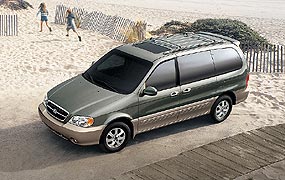![]()
![]()
![]()
![]()
![]()
![]()
![]()
![]()

![]()
|
July 7, 2005 Used
Vehicle Review:
While most of these new Kias were little more than restyled and re-badged Hyundais, the parent company decided used the Kia nameplate in 2002 to explore an automotive segment completely foreign for a Korean brand. The 2002 Kia Sedona was the first minivan to come to Canada from South Korea. If going after the minivan market was new for Kia (and Hyundai), their approach was nothing if not familiar: build an unassuming-looking vehicle with plain looks sure to appeal to many buyers, and sell it at a price that undercuts the competition. Where have we heard that one before? Size-wise, it slotted in nicely between the short- and long-wheelbase minivans: smaller than an Odyssey, larger than a Caravan, and about the same size as the previous generation Toyota Sienna. The Sedona featured lots of standard equipment including some items that were optional in competing vans. However, ABS was optional on the base model LX, and standard only on the uplevel EX, and side airbags and traction control were never offered. The term 'fully loaded' applies here in more ways than one however, as the Sedona was no lightweight, tipping the scales at a hefty 2,136 kg. Compare that to the Odyssey's 1,990 kg curb weight or the Grand Caravan's 1,881 kg, both of which are larger. The similarly-sized Sienna weighed in a comparatively svelte 1,780 kg.
But the news isn't all bad. One benefit to that heavy curb weight showed up in the Sedona's admirable performance in U.S. National Highway Traffic Safety Administration crash testing, where it earned five stars across the board: driver and passenger protection in frontal impacts, and front and rear seat occupant protection in side impacts. Its competitive prices when new and steep depreciation have combined to make a used Sedona an attractive deal. A 2002 EX model that went for $27,595 back then is now worth $14,625 according to Canadian Red Book, 53 per cent of its original value. Even a 2005 Sedona with the EX Luxury package is worth $25,000 now, 79 per cent of its original sticker price of $31,695. Those prices are cheaper than those of other import minivans, notably the Honda Odyssey and Toyota Sienna.
For its first time venturing into the deep waters of the minivan market, Kia did an okay job with the Sedona, building a safe and fairly reliable vehicle whose main fault was a little too much heft to haul around. It didn't set a new high water mark for minivan innovation, but its low resale values make it a hard-to-resist and prudent choice for someone wanting a used family hauler at a low price. Pricing Red Book Pricing (avg. retail) July 2005:
|
![]()
![]()
© Copyright 2026 Complete Automotive Recyclers. All rights reserved.
Unauthorized duplication
in part or whole strictly prohibited by international copyright law.
![]()








